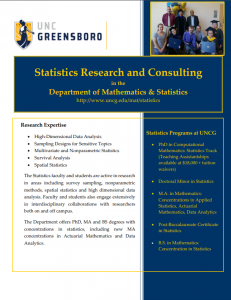Research: Statistics
About Statistics
Statistics is the scientific discipline that deals with the collection, organization, analysis, display, and interpretation of numerical data. Statistical methods are widely used to design and analyze experiments, surveys, censuses, and other approaches to collecting information about the world. Statistical analyses include the effective summarizing of sets of data and the drawing of inferences from such data, as well as identification of the nature of observational errors and sources of variability that may obscure underlying patterns.
The Nature of Statistics
Statistics provides the reasoning and methods for producing and understanding data. Statisticians are specialists, but statistics demands they be generalists, too.
Mathematics and Computers Are Involved…
Statistics uses mathematics, but it is not abstract or isolated. Statisticians work with people from other professions to solve practical problems. Statistics uses modern computing to organize and analyze data, and statisticians command specialized tools. But the emphasis is on the data to be understood and the problem to be solved, rather than on computing for its own sake.
… But Understanding the Data Is Crucial
Statisticians must know more than statistics. A statistician who works in medicine or in a manufacturing plant or in market research must learn enough medicine or engineering or marketing to understand the data in their setting. Statisticians need the ability to work with other people, to listen, and to communicate.
Statisticians can help to decide whether information is reliable or conclusions drawn from it should be trusted. Statistical methods are used widely in many kinds of work, ranging from research in the biological, social, and physical sciences to applications in law, medicine, government decision-making, finance, accounting, engineering, and actuarial work.
Statistical Consulting
The Statistical Consulting Center (SCC) offers consultation and advice to University researchers engaged in:
- the design of studies and experiments (including proposal preparation)
- the statistical and graphical analysis of data
- the appropriate choice, application and presentation of statistical methods






